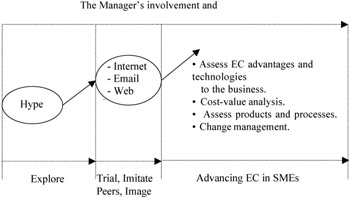Discussion
|
|
Being a new technological innovation, EC would provide diverse opportunities to SMEs to enlarge their scope and market share. However, these advantages will not accrue if SMEs do not know about these advantages (and disadvantages) in the first place, which emphasizes the importance of spreading the awareness of the technology and e-business models among the SME community
Most of the EC literature points to high adoption rates for the Internet, e-mail and Web pages among the SMEs. Whether this initial adoption is driven by media hype, pressure from peers, image enhancement, or by push from technology vendors or other concerned stakeholders is worthy of further investigation. It is worth noting that the adoption of the preceding EC technologies is not costly and does not require fundamental changes in work processes or practices (Figure 1).

Figure 1: The evolution of EC in SMEs
On the other hand, due to the low anticipated benefits from EC among the SMEs' community, this would deter many of the SMEs from advancing to more sophisticated EC initiatives. Kalakota and Robinson (2001) indicate that the impact of EC is happening in phases. The first phase (1994–1997), the EC hype was about having Web presence regardless, whether large or small businesses were aware of what they were doing or not with EC. The second phase (1997–2000) of EC was about conducting transactions where businesses started to realise some benefits out of EC such as selling and buying goods online. The third phase (2000) focuses on increasing the profitability of the online business model and how the new technology could be used strategically to maximize customer value and profits. Looking at Figure 1 above, it could be argued that SMEs are still locked in the first phase of EC. Unless something is done about this concerning fact, the gap between SMEs and EC will keep increasing (Al-Qirim & Corbitt, 2002). This chapter proposes ten factors that would assist the SMEs in progressing with EC and hence, increase their success with EC.
Knowing the real benefits that would accrue from having EC in the present and/or in the future is of importance to SMEs in order to plan their EC acquisition plans properly and not to waste valuable resources. This should be achieved in parallel with the understanding of the real impact of EC on their organizations (products and processes) and on their business environment (competition and customers/suppliers).
Despite the existing optimism among the SMEs about EC, the lack of EC profitability in the short-term will further endanger many of the EC initiatives if they base their analysis on financial cost-benefit "return on investment" measures only. On the other hand, striking a balance between the investments made on EC and the value (either tangible or intangible) accruing from having EC will further judge the success or the failure of the different EC initiatives in SMEs. Thus, an initial investment in EC, e.g., a Web page, might be motivated by an image-enhancement criteria and might not develop any further to a strategic one.
It is observed thus far that SMEs are still experimenting with the technology (adopting Internet, e-mail accounts, and Web site presence only) and are still avoiding a considerable investment in the technology (Teo et al., 1998; Waikato, 1999) (Figure 1). One possible explanation, however, is that when greater convergence of technologies and critical mass and interdependence occur, then SMEs may use electronic commerce strategically (Peters & Paynter, 1999).
However, more evidence is needed to have better insights into EC from the SMEs' perspective. Despite these impediments, recent EC literature reported wide enthusiasm for the technology and in pursuing new opportunities, which highlights seriousness in exploring the potential benefits of EC to small business. The preceding hype and interest in EC would represent the foundation for the wide diffusion of EC in SMEs provided the SMEs take into consideration the different factors highlighted in this chapter.
EC seemed a logical extension to SMEs operating within international markets; having high information-content products; technology-based or Internet-related vendors (Poon & Swatman, 1997, 1999, 1998; Abell & Lim, 1996); driven to have EC by supplier/buyer/partner; and facing intense competition over the Internet. It is worth noting that the information-content of products has led to the emergence of new businesses (mostly SMEs) over the Internet. SMEs with excess resources (usually larger ones) are more able to experiment with the technology and to sustain it for a longer time.
Most of the literature in small business highlighted the importance of the manager's role (usually the owner) in IS/EC success being the single point of authority and decision-making. The field of EC is relatively new and the actual functioning and utilization of EC-technologies are still unknown to most organizations. Thus, highly emphasizing the importance of the manager-owner innovativeness and involvement on EC success. This is necessary to guarantee EC adoption and diffusion and in providing resources, motivation, and transformation-empowerment (Figure 1).
|
|
EAN: 2147483647
Pages: 224